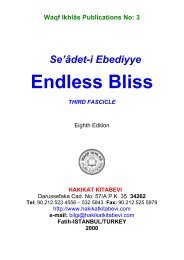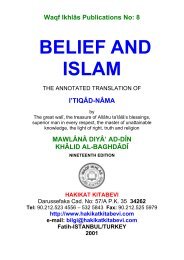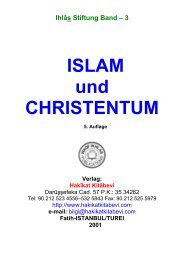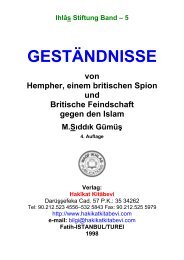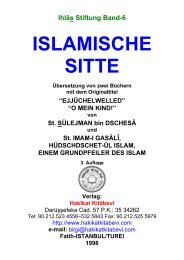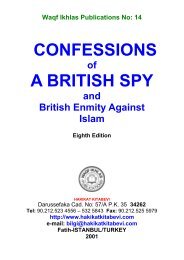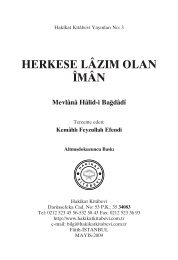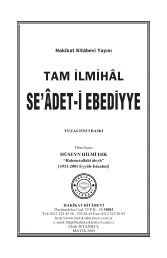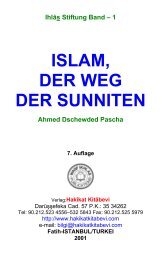- Page 1 and 2: Waqf Ikhlâs Publications No: 5 Se
- Page 3 and 4: Bismi’llâhi ’r-rahmâni ’r-r
- Page 5 and 6: order to cope up with the western i
- Page 7 and 8: TAM İLMİHÂL SE’ÂDET-İ EBEDİ
- Page 9 and 10: concerned) without any substitution
- Page 11 and 12: Allah’s sake”, and then says th
- Page 13 and 14: floating debts that are to be paid
- Page 15 and 16: spare rooms of one house. It is not
- Page 17 and 18: 672 grams. One majidiyya [An Ottoma
- Page 19 and 20: written in a fatwâ of Ebussu’ûd
- Page 21 and 22: current prices of the day when it w
- Page 23 and 24: those that are obtained after the y
- Page 25 and 26: They are valid everywhere. They are
- Page 27 and 28: mean to say that one should not giv
- Page 29 and 30: saying that in consequence they rem
- Page 31 and 32: according to Imâm-i-Muhammad, also
- Page 33 and 34: to Imâm-i-a’zam and Imâm-i-Zufe
- Page 35: to a waqf, its kharâj must still b
- Page 39 and 40: nine heads two calves over one year
- Page 41 and 42: ich man’s slave or small son. If
- Page 43 and 44: given alms for himself. Later he wi
- Page 45 and 46: unlike other insurance policies. It
- Page 47 and 48: those who serve pious foundations,
- Page 49 and 50: two places in the Qur’ân. The th
- Page 51 and 52: When he asked the reason his father
- Page 53 and 54: was a hâfiz [savant of hadîth], i
- Page 55 and 56: 7 - The fast that is harâm. It is
- Page 57 and 58: Sha’bân). On the other hand, it
- Page 59 and 60: Ramadân and Shawwâl.” It is sta
- Page 61 and 62: no longer illuminates the mountains
- Page 63 and 64: per cent mixed with saliva, if one
- Page 65 and 66: is taken into the mounth.” The sa
- Page 67 and 68: strongly believes that she would be
- Page 69 and 70: she does not begin it anew. She com
- Page 71 and 72: Hanbalî. As one person’s fitra c
- Page 73 and 74: sâ’ of wheat is lighter than 364
- Page 75 and 76: house, shop, [workshop or lorry] ,
- Page 77 and 78: addition for ’Iyd. If the rich ma
- Page 79 and 80: eing a qurbân though it was suitab
- Page 81 and 82: Allah’s name. If one does not do
- Page 83 and 84: shar’î [1] : optional and indisp
- Page 85 and 86: he gives away the living animal or
- Page 87 and 88:
foundation is like building a mosqu
- Page 89 and 90:
appointed during the vow. But it wi
- Page 91 and 92:
days. If the animals are killed bef
- Page 93 and 94:
when goods in whose comparison ther
- Page 95 and 96:
people living near that Walî’s t
- Page 97 and 98:
he comes back and they eat together
- Page 99 and 100:
disbeliever. For, a person who give
- Page 101 and 102:
mountains posts, but it has not bee
- Page 103 and 104:
a quarrel between two Muslims or be
- Page 105 and 106:
A person who performs the hajj is c
- Page 107 and 108:
and possessions it is not fard to g
- Page 109 and 110:
supererogatory hajj even when he ha
- Page 111 and 112:
command him to come back. In Ukûd-
- Page 113 and 114:
It is necessary to provide the cond
- Page 115 and 116:
a parcel or the like on your head,
- Page 117 and 118:
Women do not shave or clip their ha
- Page 119 and 120:
off their ihrâm till after throwin
- Page 121 and 122:
Muzdalfa or on the way. It is permi
- Page 123 and 124:
called Rukn-i-Iraqî, with its twen
- Page 125 and 126:
the Prophet’s ‘alaihis-salâm
- Page 127 and 128:
Its doors were no more than hanging
- Page 129 and 130:
article which has deeply hurt Musli
- Page 131 and 132:
Zoroastrian feast. On the other han
- Page 133 and 134:
couplet above denote the following
- Page 135 and 136:
Those who say that it began before
- Page 137 and 138:
number on the line belonging to the
- Page 139 and 140:
Zu’l hijja 1 2 3 4 5 6 7 ’Eid Q
- Page 141 and 142:
lived during the first two hundred
- Page 143 and 144:
one who is religious. A person who
- Page 145 and 146:
Madhhab to have two Muslim witnesse
- Page 147 and 148:
Hanbalî Madhhabs the walî has to
- Page 149 and 150:
not be sahîh. He has to say, “I
- Page 151 and 152:
MAHR - Kitâb-ul fiqh alal-madhâhi
- Page 153 and 154:
A hadîth-i sherif in the book Riy
- Page 155 and 156:
elatives even if they are not relat
- Page 157 and 158:
Muslim. She becomes a renegade at t
- Page 159 and 160:
“I have accepted this nikâh with
- Page 161 and 162:
authorized as the proxy] to know th
- Page 163 and 164:
cousin who does not have a walî cl
- Page 165 and 166:
nikâh. A Muslim who is to get marr
- Page 167 and 168:
A person who gets married should do
- Page 169 and 170:
country and if, later, the coins lo
- Page 171 and 172:
Muslims. For this purpose it is put
- Page 173 and 174:
case with an illegitimate child. On
- Page 175 and 176:
commandments and prohibitions of Al
- Page 177 and 178:
even turn to look at what will rema
- Page 179 and 180:
create any effectiveness in medicin
- Page 181 and 182:
It is an important sunna to recite
- Page 183 and 184:
the rights, the dead person has bee
- Page 185 and 186:
While explaining the thirteenth big
- Page 187 and 188:
evil eye, and biting or stinging of
- Page 189 and 190:
Thus washing and shrouding will be
- Page 191 and 192:
times. As each side is washed, wate
- Page 193 and 194:
performed for all of them if most o
- Page 195 and 196:
is not sufficient to cover the awra
- Page 197 and 198:
put) and the salât (of janâza) is
- Page 199 and 200:
15 - THE SALÂT of JANÂZA The sal
- Page 201 and 202:
jalla thenâuka” are added in the
- Page 203 and 204:
elieved that the corpse has putrefi
- Page 205 and 206:
corpse, be it his relative. We have
- Page 207 and 208:
the wooden shafts. You do not pass
- Page 209 and 210:
who shuns this responsibility by un
- Page 211 and 212:
the four Madhhabs that the grave si
- Page 213 and 214:
Arabic expression: “A’zamallâh
- Page 215 and 216:
passed away in 929 hijri. He says i
- Page 217 and 218:
deceased person will be relieved fr
- Page 219 and 220:
is a very ugly bid’at to read the
- Page 221 and 222:
do them (on your behalf). For this
- Page 223 and 224:
It is stated in the book Fatâwâ-i
- Page 225 and 226:
18 - BENEFITS of VISITING GRAVES L
- Page 227 and 228:
Bayhakî conveys from Sa’îd bin
- Page 229 and 230:
person who places such a source in
- Page 231 and 232:
savants of Mâlikî, says, “Allâ
- Page 233 and 234:
Bahâeddîn-i Bukhârî!” [1] It
- Page 235 and 236:
to the deceased by the living is to
- Page 237 and 238:
performed today are incompatible wi
- Page 239 and 240:
fidya out of that property. It is w
- Page 241 and 242:
to say, “I give you these as a pr
- Page 243 and 244:
gold coins. Hence, one gold coin ab
- Page 245 and 246:
giving (the gold coins) to the poor
- Page 247 and 248:
It is written in Majma’ul anhur a
- Page 249 and 250:
(5) If none of the inheritors menti
- Page 251 and 252:
Paternal sister gets the sudus when
- Page 253 and 254:
uterine) do not lapse from being he
- Page 255 and 256:
his children and friends. He should
- Page 257 and 258:
should be given to the poor. So-and
- Page 259 and 260:
chapter. Of the six fards, which ar
- Page 261 and 262:
number of their owners, the least c
- Page 263 and 264:
Here also, there are two cases: Fir
- Page 265 and 266:
are the fâsid [1] grandfathers, th
- Page 267 and 268:
wrote about Majalla and explained f
- Page 269 and 270:
progressive and exalting medicines.
- Page 271 and 272:
depends on various conditions: Hal
- Page 273 and 274:
sweetness coming from Him. For, pai
- Page 275 and 276:
A’ûdhu billah-imin-esh-shaytân-



